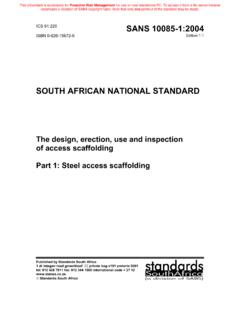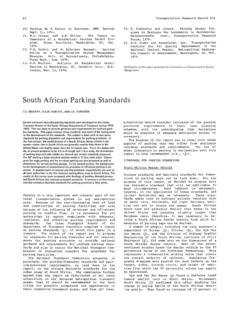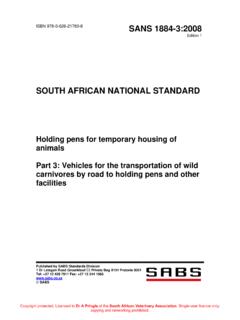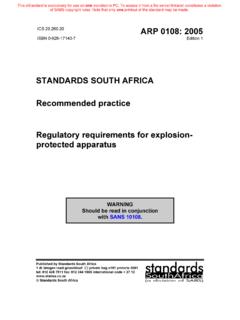Transcription of SOUTH AFRICAN NATIONAL STANDARD - …
1 ICS ; ISBN 0-626-14389-6 SANS 10353:2003 Edition 1 SOUTH AFRICAN NATIONAL STANDARD Small arms shooting ranges Published by standards SOUTH Africa 1 dr lategan road groenkloof private bag x191 pretoria 0001 tel: 012 428 7911 fax: 012 344 1568 international code + 27 12 standards SOUTH Africa 2003 SANS 10353:2003 Edition 1 Table of changes Change No. Date Scope Foreword This SOUTH AFRICAN STANDARD was approved by NATIONAL Committee STANSA TC , Firearms, ammunition and ranges, in accordance with procedures of standards SOUTH Africa, in compliance with annex 3 of the WTO/TBT agreement.
2 Annexes A, B, C, D and F form an integral part of this STANDARD . Annexes E and G are for information only. SANS 10353:2003 Edition 1 1 Contents Foreword 1 Scope .. 3 2 Definitions .. 3 3 Categories of 4 4 Potential hazards associated with shooting ranges .. 5 5 Distances over which ammunition is dangerous .. 6 6 Construction of a 6 7 Range (shooting) safety .. 9 Figures 1 to 10-11 Annex A (normative) Indoor ranges .. 12 Annex B (normative) Outdoor no danger area ranges .. 14 Annex C (normative) Outdoor danger area ranges with stop butt.
3 15 Annex D (normative) Outdoor shotgun ranges (no stop butt) for shot cartridges only .. 19 Annex E (informative) Examples of maximum ranges .. 21 Annex F (normative) Duties of the range officer .. 22 Annex G (informative) Recommended range safety rules .. 23 SANS 10353:2003 Edition 1 2 This page is intentionally left blank SANS 10353:2003 Edition 1 3 Small arms shooting ranges 1 Scope This STANDARD covers general requirements for the planning, construction and operation of indoor and outdoor shooting ranges. It does not apply to any area where it could otherwise be lawful to discharge a firearm.
4 2 Definitions For the purposes of this STANDARD , the following definitions apply: backplate steel plate that covers the area of the protected zone of an indoor range, behind and around the bullet trap, where bullet strikes are likely NOTE The backplate has no direct equivalent on an outdoor range. baffle structure or device that is mounted with its face towards the firing point. It is intended to stop or redirect misdirected shots bullet trap bullet catcher device or construction behind the targets intended to stop and trap shots that pass through or near the targets danger area fan shaped area of ground beyond the targets where those misdirected shots which do not impact on the stop butt, either in azimuth or elevation, will impact NOTE 1 A danger area is not required if the stop butt is of sufficient size.
5 NOTE 2 Only outdoor ranges can have a danger area. firing point point, or points, from which shots may be fired on the range SANS 10353:2003 Edition 1 4 protected zone sidewalls, ceiling and the floor of an indoor range, behind and around the bullet trap and backplate, intended to stop all misdirected shots that can reasonably be expected to be fired NOTE The protected zone is analogous to the stop butt on an outdoor range. ricochet bullet that continues to travel through the air after rebounding or skipping off some object or part of the range safety angle required minimum angle between the sighting line and an imaginary line drawn from the eye of the shooter to the top or side of the stop butt or protected zone shotfall area area where the shot fired from a shotgun falls sighting line imaginary line drawn from the eye of the shooter to the target small arms handguns, rifles and shotguns stop butt back stop bank, wall or other device, behind and around the bullet trap.
6 Intended to stop all misdirected shots that can reasonably be expected to be fired NOTE The stop butt applies only to outdoor ranges. 3 Categories of range General There are three basic categories of shooting range: a) indoor ranges (see annex A); b) outdoor no danger area ranges (see annex B); and c) outdoor danger area ranges (see annexes C and D). NOTE There is no essential difference between handgun and rifle ranges. However, the much higher velocities and muzzle energies of most rifle ammunition impose greater demands on the bullet trap, protected zone or stop butt, and danger area of the range. The use of a range for centre-fire rifles, in addition to handguns, will often be dependant on the economics of the necessary construction or the danger area available.
7 SANS 10353:2003 Edition 1 5 Indoor ranges An indoor range is a range that is constructed inside a building. Outdoor no danger area ranges A no danger area outdoor range is constructed or designed in such a way that no misdirected shot, which can reasonably be expected to have been fired towards the targets, will leave the range. Outdoor danger area ranges Outdoor danger area (see ) ranges are ranges where the stop butt is not sufficiently high or wide enough to comply with the requirement to contain all reasonably expected misdirected shots. Outdoor danger area ranges therefore have a danger area that extends beyond the stop butt.
8 In the case of shotgun ranges, there is no stop butt, and the danger area becomes the shotfall area. 4 Potential hazards associated with shooting ranges Indoor range potential hazards The following potential hazards should be taken into consideration when an indoor shooting range is being designed and constructed: a) bullets that strike some part of the range other than the bullet trap and ricochet so as to pose a hazard to shooters or to a third party; b) splashback of particles from target frames, from the bullet trap or from any other item within the protected zone; c) noise from the discharge of firearms that damage the hearing of the shooters; d) noxious fumes from propellant gases.
9 E) lead dust and particles from unjacketed bullets; f) risk of fire from dust build-up and from tracer ammunition; g) ejected cartridge cases or gas and propellant particles that can strike an adjacent shooter; h) inadequate lighting that affects the shooter's ability to clearly see the sights and targets; and i) incorrect usage of the range. Outdoor range potential hazards The following potential hazards should be taken into consideration when an outdoor shooting range is being designed and constructed: a) bullets that miss the stop butt and leave the range; b) bullets that strike some part of the range other than the stop butt, ricochet, miss the stop butt, and thus leave the range; SANS 10353:2003 Edition 1 6 c) splashback of particles from target frames, from the bullet trap or from the stop butt; d) noise from the discharge of firearms that damage the hearing of the shooters.
10 E) ejected cartridge cases or gas and propellant particles that can strike an adjacent shooter; f) glare from the sun that affects the shooter's ability to clearly see the sights and targets; g) people who enter the danger area or the range itself; h) incorrect usage of the range; and i) any extraordinary hazards, for example low-flying aircraft from a nearby airfield. 5 Distances over which ammunition is dangerous The danger area dimensions mentioned in annexes C and D take into consideration the distances over which ammunition is dangerous. NOTE Small arms projectiles will travel a considerable distance (see annex E) when fired at a slight elevation angle.









